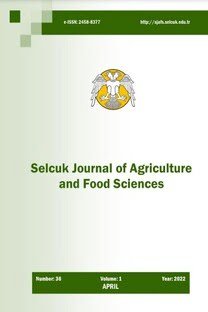Kavun Fusarium solgunluğuna bazı biotik ve abiotik uyarıcıların etkileri
Kavun solgınluk hastalığına bazı biotik ve abiotik uyarıcıların etkilerini belirlemek için yürütülen bu çalışmada, biotik uyarıcı olarak kavundan izole edilen nonpatojenik Fusarium oxysporum ile ilgisiz F.oxysporum f.sp. lycopersici ve F.oxysporum f.sp. phaseoli izolatlan, abiotik uyarıcı olarakda Trifluralin ve Acetochlor herbisitleri kullanılmıştır. Saksı koşullarında yapılan çalışmada hastalığa karşı en yüksek etki % 47. 62 ile nonpatojenik F.oxysporum (Erğ-Gy 2000/2) izolatından elde edilmiştir.Bunu diğer nonpatojen F. oxysporum (Ak-Sl 2000/1) izolatı takip etmiştir. Tarla denemelerinde elde edilen etkiler saksı denemelerinden elde edilen etkilerden daha düşük olmuştur. Abiotik uyarıcı olarak kullanılan Trifluralin ve Acetochlor hem saksı hemde tarla koşullarında hastalığa karşı etkili olmuşlardır.Saksı koşullarında trifluralin 96 jul/ m2 dozunda hastalığa karşı % 57.14 oranında etkili olurken, acetochlor 168 fil/ m2 dozunda % 52.32 oranında etkili olmuştur. Tarla koşullarında her iki herbisitden elde edilen etki, saksı koşullarında elde edilen etkiden daha düşük olmuştur.
Anahtar Kelimeler:
Fusarium oxysporum, trifluralin, bitki hastalıkları, mantar öldürücüler, bitki patolojisi, Fusarium, solgunluk hastalığı, kavun, asetoklor, bitki hastalıkları kontrolü, Fusarium oxysporum f.sp. lycopersici, Fusarium oxysporum f.sp. phaseoli
Effects of some biotic and abiotic inducers on melon Fusarium wilt
The present research was conducted to determine the effects of some biotic and abiotic inducers on melon Fusarium wilt. Unrealeted Fusarium oxysporum f.sp. lycopersici and Fusarium oxysporum f.sp. phaseoli with non-pathogenic Fusarium oxysporum isolated from melon were used as biotic and Trifluralin and Acetochlor herbicides used as abiotic inducer in this research. A study conducted in pot conditions, the highest effect was obtained from non- pathogenic F. oxysporum (Erğ-Gy 2000/2) isolate with the rate of 42.62 % against melon Fusarium wilt disease. From unrelated Fusarium isolates were obtained lower effects than non-pathogenic Fusarium oxysporum isolates. The effects observed from field studies were lower than those from pot studies. Trifluralin and Acetochlor used as abiotic inducers had an effect on the disease in both and field conditions. 96 fil/m2 dose of trifluralin showed an effect with the rate of 57.14 % while 168 fil/m2 dose of acetochlor had an effect with the rate of 52.32 % on the disease in the pot conditions. The effects of both herbicides infield conditions were lower as compared to their effects in pot conditions
Keywords:
Fusarium oxysporum, trifluralin, plant diseases, fungicides, plant pathology, Fusarium, wilts, melons, acetochlor, plant disease control, Fusarium oxysporum f.sp. lycopersici, Fusarium oxysporum f.sp. phaseoli,
___
- Agrios, G. N., 1997. Plant Pathology. Fourth Edition. Academic Pres. USA. 635 pp.
- Akgül, S., 2002. Kavunda Fusarium solgunluğuna karşı Trifluralin ve Acetochlor Herbisitleri Kullanılarak Dayanıklılığın Teşvik Edilmesi. Çukurova Üniv., Fen Bil. Enst. Bitki Koruma Anabilim Dalı, Yüksek Lisans Tezi, Adana, s. 43
- Biles, C. L. and R. D. Martyn, 1989. Local and Systemic Resistance Induced in Watermelons by formae speciales of Fusarium oxysporum. Phytopathology, 79: 856-860.
- Bora, T., ve H. Özaktan, 1998. Bitki Hastalıklarıyla Biyolojik Savaş. Prizma Matbaası, Alsancakİzmir. s. 85-95.
- Cohen, R., J. Rıov, N., Lısker And J. Katan, 1986. Involvement of Ethylene in Herbicide-induced Resistance to Fusarium oxysporum f. sp. melonis. Phytopathology, 76: 1281-1285.
- Cohen, R., O. Yarden., and J. Katan, 1987. Paclobutrazol and Other Plant Growth- Retarding Chemicals Increase Resistance of Melon Seedlings to Fusarium Wilt. Plant Pathology, 36: 558-564.
- Cohen, R.,B. Blaır, and J. Katan, 1992. Chloroacetamide Herbicides reduce incidence of Fusarium wilt in melons. Crop Protection. 11: 181-185.
- Cohen, R., B. Blaır, A. A. Schaffer and S. Katan, 1996 Effect of Acetochlor Treatment on Fusarium wilt and Sugar Content in Melon Seedlings. European J. Plant Pathol., 102: 45-50.
- Erzurum, K., and S. Maden, 1994. Efficacy of Trifluralin, nonpathogenic Fusaria and Colletotrichum lagenarium for the control of Fusarium Wilt of Melon . 9th congress of the Mediterranean Phytopathological Union- Kuşadası-Aydın,Türkiye, 367-369 pp.
- Gessler, C. and J. Kuc, 1982. Induction of resistance to Fusarium wilt in cucumber by root and foliar pathogens. Phytopathology, 72: 1439-1441.
- Lıu, L., J. W. Kleopper and S. Tüzün, 1995. Induction of Systemic Resistance in cucumber against Fusarium Wilt by plant Growth-promoting Rhizobacteria. Phytopathol., 85: 695-698.
- Maden, S. and O. Karahan, 1980. A new root and foot-rot disease of melons (Phytophthora drecchsleri Tucker) in Central Anatolia and its pathogenicity on common melon cultivars in this region. J. Turkish Phytopath., 9(1): 49-55.
- Ogawa, K. and H. Komada, 1985. Biological control of Fusarium wilt of sweet potato with Crossprotection by nonpathogenic Fusarium oxysporum. (C. A. parker, A. D. Rovira, K. J. Moore, P. T. W. Wong, J. F. Kollmorgen eds). Ecology and Management of Soilborne Plant Pathogens, APS pres, 121-123 pp.
- Postma, J., and H. Rattınk, 1992. Biological Control of Fusarium wilt of Carnation with a Nonpathogenic Isolate of Fusarium oxysporum Can. J. Bot., 70: 1199-1205.
- Tezcan, H., 1991. İzmir ve Manisa İllerinde Kavunlarda Görülen Fungal Kaynaklı Kuruma Nedenleri Üzerinde Araştırmalar. Ege Üniv. Fen Bil. Enst. Bitki Koruma Anabilim Dalı. Doktora Tezi, 80 s. İzmir.
- Yıldız, M., 1977. Ege Bölgesinde Kavun Solgunluk Etmeninin Patojenisitesi, Irkları ve Yerel Çeşitlerinin Dayanıklılıklarının Saptanması Üzerine Araştırmalar E. Ü. Ziraat Fak. Bitki Koruma Böl. Doçentlik Tezi, 112 s.
- ISSN: 1300-5774
- Yayın Aralığı: Yılda 3 Sayı
- Başlangıç: 2018
- Yayıncı: Selçuk Üniv. Ziraat Fak.
Sayıdaki Diğer Makaleler
Burçak (Vicia ervilia (L.) Willd.)' ta ekim zamanının verim ve verim öğeleri üzerine etkisi
ABDULLAH ÖZKÖSE, HAYRETTİN EKİZ
Kibar AK, Meryem UYSAL, CELAL TUNÇER, Hüseyin AKYOL
Kavun Fusarium solgunluğuna bazı biotik ve abiotik uyarıcıların etkileri
Cin mısırı çeşitlerinin tane verim ve önemli kalite özelliklerinin belirlenmesi
Alper TEKKANAT, SÜLEYMAN SOYLU
Lale soğanlarında Fusarium çürüklüğünün oranı ve kimyasal mücadelesi
Mısır bitkisinin ilk gelişimine kompostlaştırılmış tuzlu tavuk gübresinin etkisi
CEVDET ŞEKER, Ersoy İlknur GÜMÜŞ, MEHMET ZENGİN
Konya Ovasındaki sulama örgütlerinin işletmecilik yönünden karşılaştırılması
